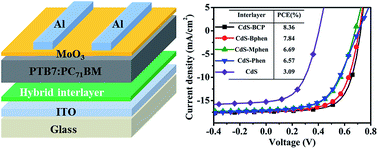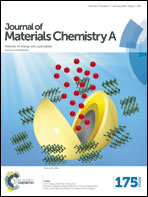CdS–phenanthroline derivative hybrid cathode interlayers for high performance inverted organic solar cells†
Abstract
Phenanthroline based organic semiconductors (BCP, Bphen, Mphen, and Phen) are used to hybrid with CdS as cathode interlayers in inverted organic solar cells (OSCs). We observed that selecting the polar solvent and hydrophobic interlayers with a diphenyl group could improve the performance of the organic photovoltaic devices. The modification to CdS can effectively improve its electron mobility, film morphology, interfacial contact, and energy level alignment, which finally leads to a significant enhancement of device performance. Through incorporating the CdS–P hybrids (CdS–BCP, CdS–Bphen, CdS–Mphen, and CdS–Phen) as cathode buffer layers, the device PCE (PTB7 : PC71BM as the active layer) is greatly improved from 3.09% to 8.36, 7.84, 6.69, and 6.57%, respectively, compared with devices fabricated on the pristine CdS interlayer. These results indicate that the common inorganic semiconductor like CdS can be modified using some organic semiconductors to produce general applicable electron transport layers applied in OSCs. Our work puts forward new insights for the development of new interface modification materials and fabrication of high efficiency devices.


 Please wait while we load your content...
Please wait while we load your content...